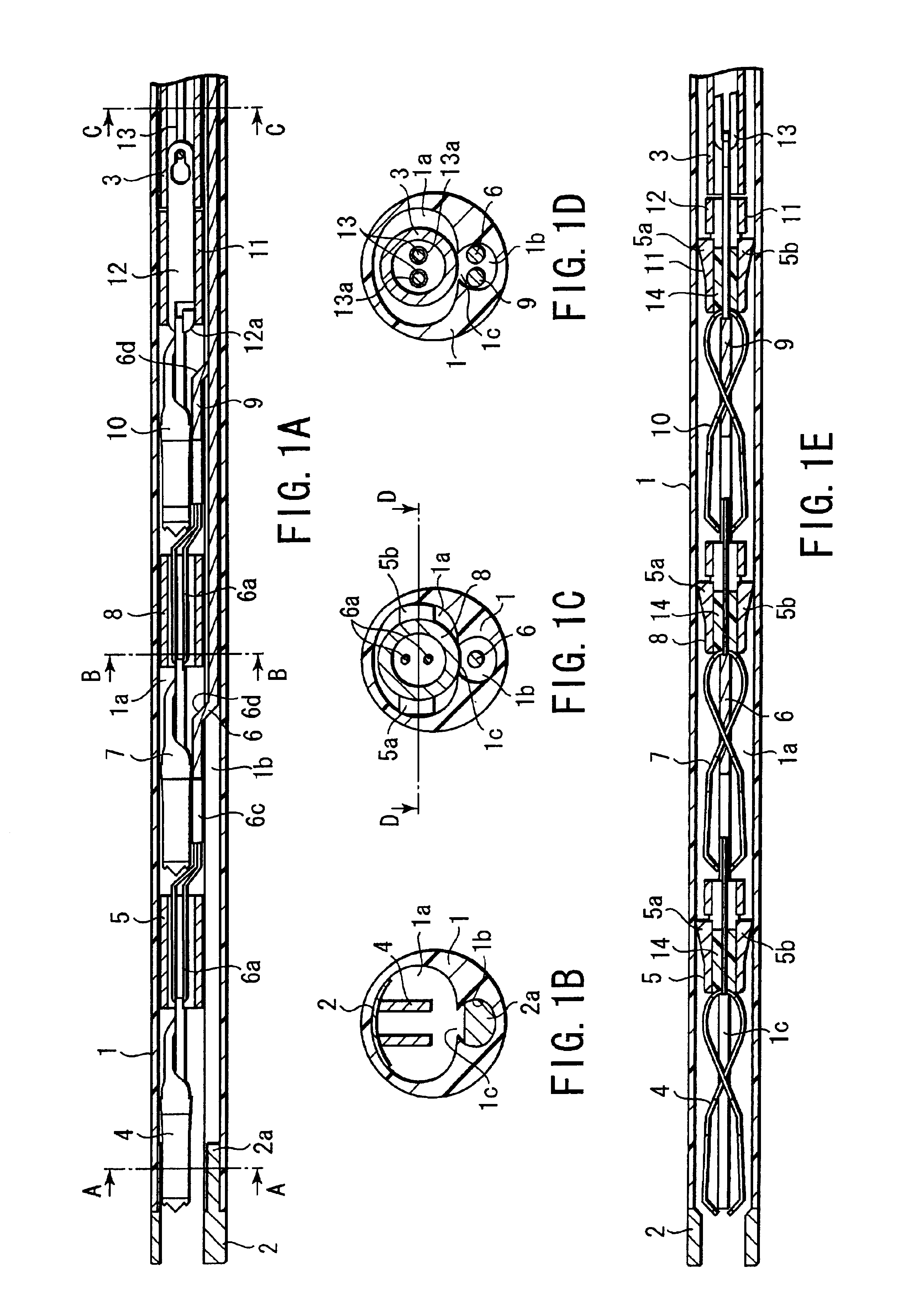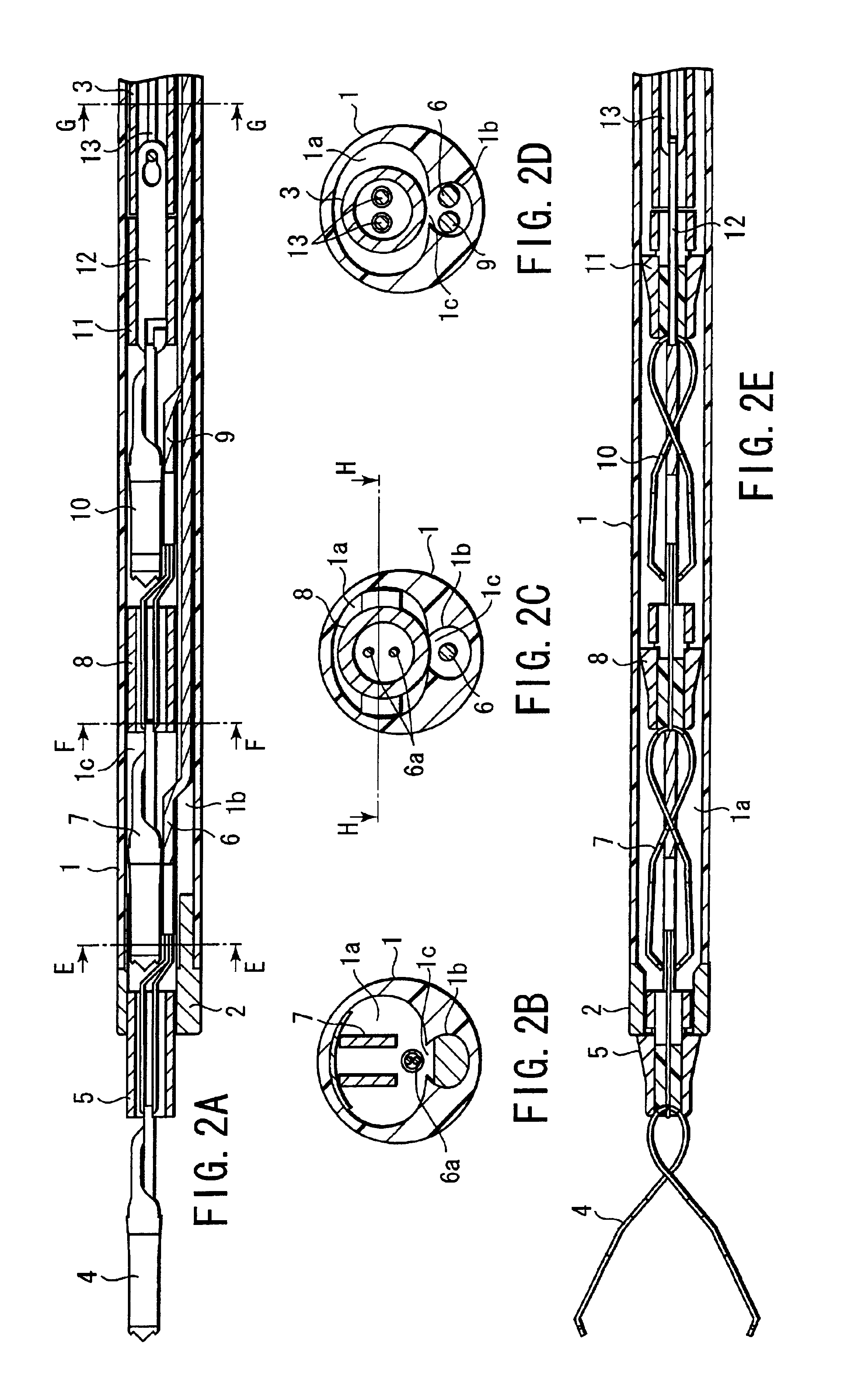Apparatus for ligating living tissues
a technology of living tissue and ligating apparatus, which is applied in the field of living tissue ligating apparatus, can solve the problems of high emergency, complicated and time-consuming work, and high difficulty in reducing patient pain, so as to reduce the time of surgical operation, reduce pain, and facilitate the effect of operation
- Summary
- Abstract
- Description
- Claims
- Application Information
AI Technical Summary
Benefits of technology
Problems solved by technology
Method used
Image
Examples
first embodiment
[0086]FIG. 1A to FIG. 11 show the present invention. As shown in FIG. 1A and FIG. 1E, an introducing tube 1 has flexibility such that the tube can be inserted into an endoscope channel. A distal end tip 2 is provided at a distal end portion of this introducing tube 1. The introducing tube 1 is provided as a tune sheath that consists of a polymeric resin described later, for example, and a first tube channel 1a and a second tube channel 1b are provided in parallel to each other over an axial direction.
[0087]As shown in FIG. 1B to FIG. 1D, the first tube channel 1a is formed in a substantially oval shape on its transverse cross section, and has a large inner diameter so that a clip and a clip tightening ring described later can be inserted. The second tube channel 1b is also formed in a substantially oval shape on its transverse cross section, and has a small inner diameter so that a manipulating wire described later can be inserted. The first tube channel 1a and second tube channel 1...
third embodiment
[0133]Now, working of a third embodiment will be described here.
[0134]The introducing tube 30 of the ligating apparatus is introduced into a body cavity via the endoscope channel inserted into the body cavity. Then, a distal end portion of the introducing tube 30 is located in close proximity of a clipping target tissue, for example, a gastric mucous membrane tissue. When a retracting side 34b of the manipulating wire 34 inserted into the second tube channel 30b is retracted to the frontal side of the introducing tube 30, the manipulating wire 34 is returned to form a loop section at a portion of the holding element 33. Then, an advancing side 34a of the manipulating wire 34 advances to the distal end side of the introducing tube 30. Therefore, as shown in FIG. 14A to FIG. 14E, the most frontal clip 4 and clip tightening ring 5 are protruded from the distal end portion of the distal end tip 31.
[0135]When the clip tightening ring 5 is located in the distal end tip 31, the ring drops ...
fourth embodiment
[0151]Now, working of a fourth embodiment will be described here.
[0152]The introducing tube 50 of the ligating apparatus is introduced into a body cavity via the channel of the endoscope inserted into the body cavity. Then, a distal end portion of the introducing tube 50 is located in close proximity to a clipping target tissue, for example, a gastric mucous membrane tissue. When the retracting side 54b of the manipulating wire 54 inserted into the second tube channel 50b is retracted to the frontal side, the manipulating wire 54 is returned to from a loop section at the arc shaped portion 51c of the holding element 51. Then, the advancing side 54a of the manipulating wire 54 advances to the distal end side of the introducing tube 50. Therefore, as shown in FIG. 19, the clip 4 and clip tightening ring 5 at the most frontal portion of the introducing tube 50 are protruded diagonally upwardly from the opening portion 50d.
[0153]As shown in FIG. 20, when the clip tightening ring 5 is l...
PUM
 Login to View More
Login to View More Abstract
Description
Claims
Application Information
 Login to View More
Login to View More - R&D
- Intellectual Property
- Life Sciences
- Materials
- Tech Scout
- Unparalleled Data Quality
- Higher Quality Content
- 60% Fewer Hallucinations
Browse by: Latest US Patents, China's latest patents, Technical Efficacy Thesaurus, Application Domain, Technology Topic, Popular Technical Reports.
© 2025 PatSnap. All rights reserved.Legal|Privacy policy|Modern Slavery Act Transparency Statement|Sitemap|About US| Contact US: help@patsnap.com



